牛津译林版-英语-八上-8A-教案设计-1单元 Friends Grammar
- 格式:docx
- 大小:19.82 KB
- 文档页数:5
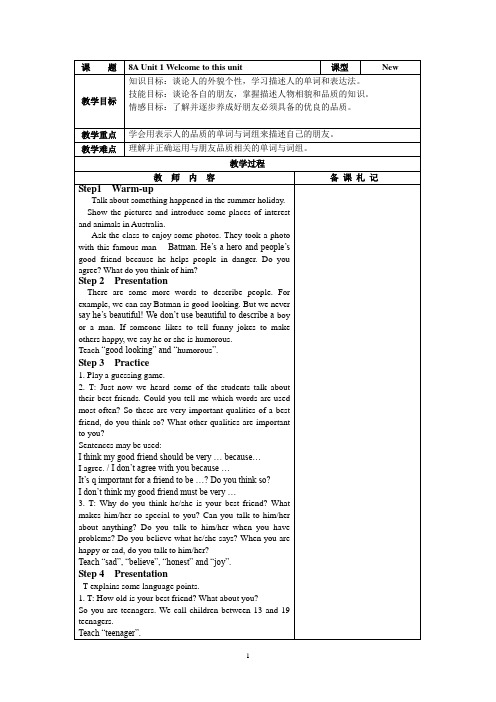
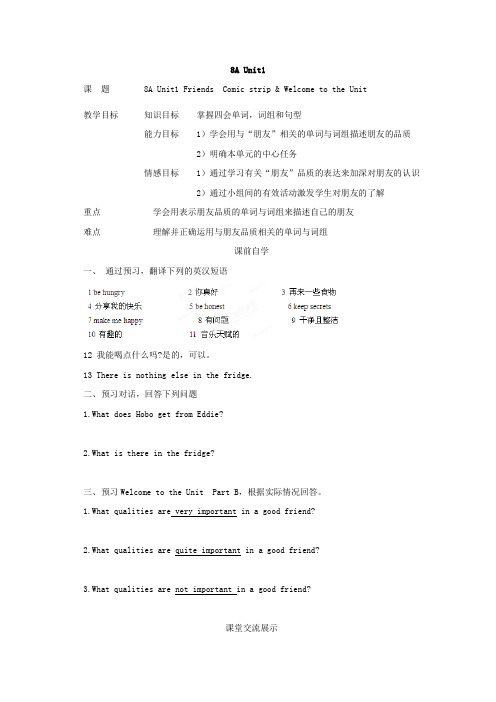
8A Unit1课题8A Unit1 Friends Comic strip & Welcome to the Unit教学目标知识目标掌握四会单词,词组和句型能力目标1)学会用与“朋友”相关的单词与词组描述朋友的品质2)明确本单元的中心任务情感目标1)通过学习有关“朋友”品质的表达来加深对朋友的认识2)通过小组间的有效活动激发学生对朋友的了解重点学会用表示朋友品质的单词与词组来描述自己的朋友难点理解并正确运用与朋友品质相关的单词与词组课前自学一、通过预习,翻译下列的英汉短语12 我能喝点什么吗?是的,可以。
13 There is nothing else in the fridge.二、预习对话,回答下列问题1.What does Hobo get from Eddie?2.What is there in the fridge?三、预习Welcome to the Unit Part B,根据实际情况回答。
1.What qualities are very important in a good friend?2.What qualities are quite important in a good friend?3.What qualities are not important in a good friend?课堂交流展示一. 听录音,回答Comic strip问题1 What does Eddie give Hobo?2 Is there anything else in the fridge?3 What does Hobo want? Why?二、朗读对话,并且小组内分工合作表演对话三、根据对话内容,完成下面短文Today Hobo was ________. Eddie gave him ___________ and some_______. Hobo wanted to have ____________ food. But there was ____________ in the fridge. At last, Eddie had to _________ the pizza with Hobo.四、小组讨论,Who do you like better as a friend, Eddie or Hobo? Why?五、根据上面的讨论,得出好朋友应该具备的那些品质,展示预习检测的第三题。
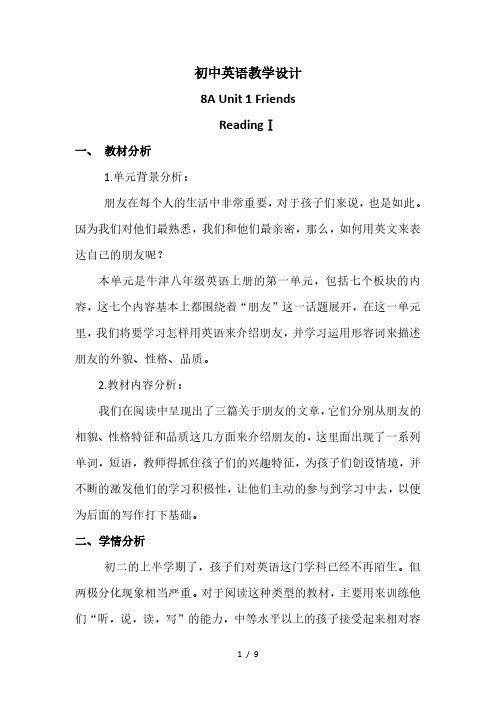
初中英语教学设计8A Unit 1 FriendsReadingⅠ一、教材分析1.单元背景分析:朋友在每个人的生活中非常重要,对于孩子们来说,也是如此。
因为我们对他们最熟悉,我们和他们最亲密,那么,如何用英文来表达自己的朋友呢?本单元是牛津八年级英语上册的第一单元,包括七个板块的内容,这七个内容基本上都围绕着“朋友”这一话题展开,在这一单元里,我们将要学习怎样用英语来介绍朋友,并学习运用形容词来描述朋友的外貌、性格、品质。
2.教材内容分析:我们在阅读中呈现出了三篇关于朋友的文章,它们分别从朋友的相貌、性格特征和品质这几方面来介绍朋友的,这里面出现了一系列单词,短语,教师得抓住孩子们的兴趣特征,为孩子们创设情境,并不断的激发他们的学习积极性,让他们主动的参与到学习中去,以便为后面的写作打下基础。
二、学情分析初二的上半学期了,孩子们对英语这门学科已经不再陌生。
但两极分化现象相当严重。
对于阅读这种类型的教材,主要用来训练他们“听,说,读,写”的能力,中等水平以上的孩子接受起来相对容易,而对于潜能生来说,就有一定的困难了。
要想尽各种办法,不落下任何一个孩子,不断的激发他们的课堂兴趣,调动他们的学习热情,让他们能够主动的参与到学习中去,成为学习的主人,从而进一步缩短差距,全面提高他们的综合能力,提高班级的整体素质。
三、教学目标掌握一些单词、短语和句子(描写朋友的);学会描写自己的朋友。
四、教学重点和难点掌握一些新的单语、短语和句子,并能用所学新知识描述自己身边的朋友。
五、学习策略1.课前认真预习,对于自己的拦路虎,提前圈出来,并认真思考。
2.课中认真听课,勤思考,多动脑,及时做笔记,尽快的掌握所学词汇,充满热情,积极主动地参与课堂上的各种活动。
3.课下及时复习,并认真完成各科作业。
六、具体步骤Ⅰ.Teaching purpose1.Targe t of language knowledgeTo learn the new words, phrases and the useful expressions in the text.2.Target of language technique.a. To train the students’ abilities of listening ,speaking and reading.b. To skim the text for overall meanings and finish the exercises for comprehension.3.Target of attitude emotionTo love friends and use adjectives to describe people ’appearance and characteristics.Ⅱ.Teaching knowledgeWords: generous, singer, almost, round, bored, straight, sweetPhrases: a good sense of humor, feel bored, say a bad word about anyone, a true friend, keep a secret, tell funny jokesSentences: She is also helpful and ready to help people any time.She wants to be a singer when she grows up.May is my best friend.She is shorter than I am.She smiles often and never says a bad word about anyone.Ⅲ.Teaching importance and difficulties1.To grasp the language points in the three articles.2.To understand the use of comparatives and superlatives.3.To recite the three articles and describe people with proper adjectives.Ⅳ.Teaching repairMulti-media, computer, tape-recorderⅤ.Teaching proceduresStep1: Lead-in (2min)T: Last period, we talked about friends. In our lives, friends are very important for us. Everyone needs a friend. Do you think so?Ss: Yes.(用孩子们亲近的,熟悉的话题入手,能引起他们的共鸣,吸引孩子们主动参与并积极思考,从而调动他们的学习积极性。
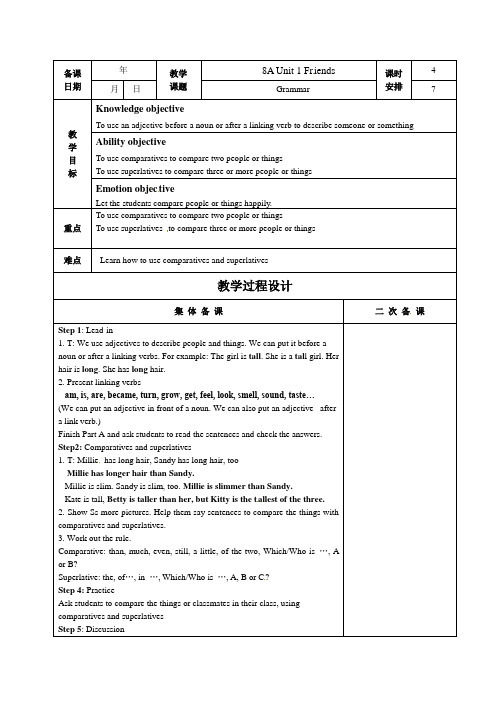

译林牛津版八年级英语上Unit 1 Friends vocabulary 教学设计(表格式)8A Unit 1 FriendsContent: VocabularyPeriod:10-4Teaching aims and demands:a. Aims to knowledge:Words: thin, square, round, good-looking, handsome.b. Aims to the abilities:To use adjectives to describe people’s physical features.To select and use adjectives that are appropriate to describe the appearance of boys and girls.Key points and difficult points:1. Grasp some new adjectives.2. To select and use adjectives that are appropriate to describe the appearance of boys and girls.Teaching aids:Some pictures and some blank pieces of paper.Teaching methods:Group workTeaching procedures:Step 1 Check homeworka. Ask some questions according to the text. What is Betty, Max or May like b. Ask: What is your best friend like (Students say or read their articles)c. Ask: Is your friend strong/thin Are your friend’s eyes big/small Is your friend’s short/tall Is your friend’s face square/round (Finish Part A)Step 2: Discuss and finish vocabulary B.1. Go through the words in the box in Part B. Then ask students to complete the lists in groups of 4-5. Check answers orally with the class.2. Tell students more adjectives for describing eful wordsBuild(体形)Well-built, slim, thin, fat, strong,NoseFlat, pointed, long, short,HeightShort, tall, medium height, medium-sized,FaceSquare, round, fat, thin, EyesBig, small, black, brown, blueHairLong, short, shoulder-length, straight, wavy, Show some pictures to students and ask them to describe.Step 3: DrawingDivide students into groups of five. Give a pictures to only one student in each group and ask him/her not to show it to the other students. Give blank pieces of paper to the other students. The student with the picture describes the features of the person in the picture while the other students draw the person. Then display the drawings together with the original picture. Ask students to vote for the best drawing.VI .On Blackboard: Unit 1 VOCABULARYUseful wordsBuildWell-built, slim, thin, fat, strong,NoseFlat, pointed, long, short,HeightShort, tall, medium height, medium-sized,FaceSquare, round, fat, thin, EyesBig, small, black, brown,blueHairLong, short, shoulder-length, straight, wavy, Ⅶ. Homework:Translation:我有个名叫彼得的堂哥。
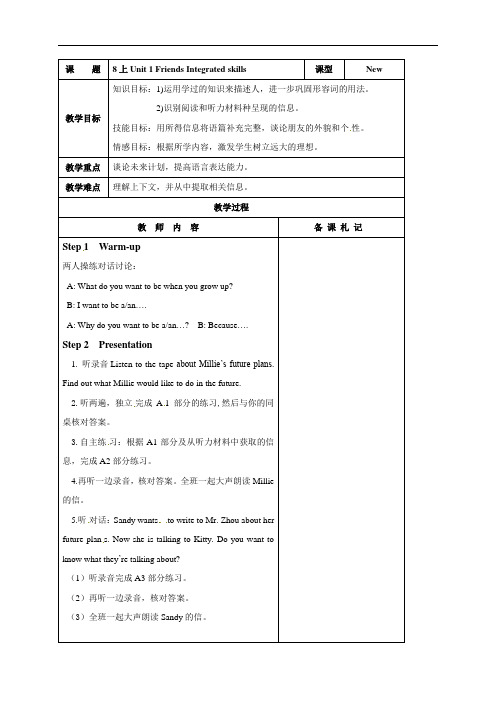
知识目标:1)运用学过的知识来描述人,进一步巩固形容词的用法。
2)识别阅读和听力材料种呈现的信息。
技能目标:用所得信息将语篇补充完整,谈论朋友的外貌和个性。
情感目标:根据所学内容,激发学生树立远大的理想。
Step1 Warm-up两人操练对话讨论:A: What do you want to be when you grow up?B: I want to be a/an….A: Why do you want to be a/an…? B: Because….Step 2 Presentation1. 听录音Listen to the tape about Millie’s future plans.Find out what Millie would like to do in the future.2.听两遍,独立完成A1部分的练习,然后与你的同桌核对答案。
3.自主练习:根据A1部分及从听力材料中获取的信息,完成A2部分练习。
4.再听一边录音,核对答案。
全班一起大声朗读Millie的信。
5.听对话:Sandy wants to write to Mr. Zhou about herfuture plan s. Now she is talking to Kitty. Do you want toknow what they’re talking about?(1)听录音完成A3部分练习。
(2)再听一边录音,核对答案。
(3)全班一起大声朗读Sandy的信。
Step 3 Practice小组活动:操练对话,进一步谈论人的外貌,个性和未来计划。
A: Who’s the girl /boy on your left/right?B: She/He is …A: What is she/he like?B: She/He is …A: What does she/he want to be when she/he grows up?B: …A: Wh y does she/he want to be…?B: Because…Step 4 Presentation听对话录音,回答下列问题:(1) Who is th e boy on the left?(2) What is he like?(3) Does he run fast?(4) What would he like to be when he grows up?Step 5Practice合作展示:(1)跟录音朗读对话,然后与你的搭档配合表演对话。
八年级英语8aUnit 1 Friends Integrated Skills教学案学习目标1)掌握和运用本课时的四会单词。
2)掌握本课表达个人未来打算的句型:I would like to…/I want to…I hope to…课前自学一、需要预习的单词和词组solve problems make friends with try to be kind to peopletry one’s best to do sth. next to二、使用一些形容词来描述影星成龙Can you describe ChengLong?He is a Social Worker.(汉语意思:_______________)三、词组互译1、为人们歌唱2、听取别人的问题3、解决问题4、交朋友5、环游世界6、尽力做某事7、长大8、看起来爱好体育的四、在做听力之前好好阅读16页的听力材料课堂交流展示一、听录音Listen about Millie’s future plansFind out what Millie would like to do in the future二、核对答案三、小组讨论What is Millie like? What d oes she want to do?四、完成下面的短文Dear EditorMy name is Millie. I am a Grad e 8 student. I alw ays try to be _________to people. I have many friends in my class. I feel unhappy when my friends are sad. I try my best to help them. I would like to be a social worker when I grow up. The n I can ___________ to people’s problems and help them solve their ____________. I will b e happy if I can make people _________ again.Millie五、Millie would like to be a social worker to make people happy,Sandy also wants to make others happy.听录音,完成下面短文Dear EditorI am really happy to tell you about my future plans. I like singing and I want to be a singer. It is great to ____________ for people. I’d like to make people ___________ .My favourite ___________ is Britney Spears. I want to be as ______________ as she is when I grow up. I hope to become a famous singer and ____________ around the world in the future.六、Speak Up:talking about friends听录音,回答问题:1 What is Peter like?2 What would Peter lik e to be when he grows up?3 Does Peter look sporty?七、朗读对话,小组编写新的对话,并且展示课堂达标检测一、根据汉语意思,完成句子1 他们想今天完成这个工作。
牛津译林版八年级上册Unit 1《Friends》(Grammar)教学设计一. 教材分析《Friends》是牛津译林版八年级上册Unit 1的教学内容,本节课主要讨论朋友和友谊这一主题。
教材通过描述不同人物的性格特点和他们的友谊,引导学生学习一般现在时态的肯定句和疑问句以及一般现在时态的被动语态。
本节课的内容与学生的生活紧密相连,有利于激发他们的学习兴趣和积极性。
二. 学情分析八年级的学生已经具备了一定的英语基础,能够听懂并运用一般现在时态。
但他们在语言表达方面还存在一定困难,需要通过大量的操练来提高他们的语言运用能力。
此外,学生的学习动机和学习态度对他们的学习效果有重要影响,因此,教师需要设计有趣且富有挑战性的教学活动来激发他们的学习兴趣。
三. 教学目标1.知识目标:学生能够掌握一般现在时态的肯定句、疑问句和被动语态,并能够运用所学知识进行简单的交流。
2.能力目标:学生能够通过听力、口语、阅读和写作等多种方式,运用一般现在时态进行表达和交流。
3.情感目标:学生能够理解友谊的重要性,学会珍惜和维护友谊。
四. 教学重难点1.重点:学生能够掌握一般现在时态的肯定句、疑问句和被动语态。
2.难点:学生能够运用一般现在时态进行流畅的口语表达和交流。
五. 教学方法1.任务型教学法:通过设计各种真实且有意义的任务,引导学生参与课堂活动,提高他们的语言运用能力。
2.交际法:通过模拟真实场景,让学生在实际交流中学会运用一般现在时态。
3.情境教学法:通过创设各种情境,激发学生的学习兴趣和积极性。
六. 教学准备1.教学课件:制作含有动画、图片和例句的教学课件,帮助学生更好地理解和记忆。
2.练习册:准备与本节课内容相关的练习册,用于巩固所学知识。
3.听力材料:准备与本节课主题相关的听力材料,帮助学生提高听力技能。
七. 教学过程1.导入(5分钟)通过向学生提问“你的朋友是什么样的人?”等问题,引导学生谈论朋友和友谊,激发他们的学习兴趣。
Step1 Revision1.What are the most important qualities of a good friend?2.What are the very important qualities of a good friend?3. What’s your good friend like?Step 2 Presentation1. T: I have a good friend. Do you want to know her? What do you want to know about her?2. Show a picture. Describe my good friend. Introduce some new expressions: as tall as; be willing to; have a good sense of humor; feel boredStep 3 Fast readingT: ‘Teenagers’ magazine is holding a writing competition. Some students have written some entries for it. Please read and find out their main qualities.1---g enerous, helpful2---humorous (have a good sense of humor), funny3---true friend, kindStep 4 Read for detailsComplete the table after reading their entries once more. Step 5 Retell1. T: So we have got a table about them. And you have known a lot a bout them. Can you say sth about them according to the information in the table.2. Give Ss 3 minutes to prepare3. Ask 2-3 Ss to retell the three articles.Step 6 Brainstorming1.T: Well, when we describe our friends, we also need to describe what he or she is like. What kind of words can we use? ---Adjectives.Eyes, nose: big, smallFace: round, squareBody: thin, strong, slim, fat, tall, shortHair: short, long, straight, circled, shoulder-length2. We can use so many useful words to describe people. Is there any difference in describing boys and girls? Can you give me any examples?(write down some words in the list on Page 7)Step 7 Homework1. Recite t he new words and phrases.2. Finish the Workbook exercises.3.完成下列句子(每格一词):Betty长大后想周游世界。
8上Unit 1 Friends Reading (2)Step 1 RevisionT: We have learnt some words to describe your friends, c an you introduce your friend to us?Others please guess who it is?Ask 3-4 Ss to read their articles.Step 2 Some more exercises1. T: Let’s meet our old friends ag ain. Mr Zhou has some problems in describing them. Can you help him finis h his sentences? Do Exe B2 on P52. Find out their photos according to Mr Zhou’s description.3. Mr Zhou is writing some notes about them. Is he right?4. V otingSuppose you are going to vo te for the best friend among these three students, what is your choice? Why?Step 3 Voting in your own classDo you have such a good friend in you class, or around you? Please vote for him or her, and tell us your reason. (talk about qualities)Step 4 Language points1.T: now let’s look at some useful expressions in thepassages.Give Ss some phrases for them to translate: 与…一样苗条as slim as乐于做某事be willing to do sth.准备好做某事be ready to do sth.帮助我做家庭作业help me with my homework因为太多工作because of too much work戴眼镜wear glasses有很好的幽默感have a good sense of humour感到厌倦feel bored使我笑make me laugh走路经过walk past撞翻knock over说某人坏话say a bad word about sb.2.Read them together, and ask Ss to use some of them to make sentences.3. T: Do you have any problem in the passages?4. Answer any question Ss may haveStep 5 Practice单词拼写根据括号内的提示或首字母填写正确的词(每空一词):1. ---What do you think of May?---She is so (love) that we all like her.2. ---Does Jim do his homework as (care) as Tom? ---Yes, I think so.3. ---Daniel will watch TV when he feels _____ (bore) at home. ---So will I.4. My best friend Max has poor e , so he must wear glasses all day.5. Look! Tony is wearing his father’s sweater. Helooks . (fun)6. I don’t like watching TV because of too many . (广告)7. It is rain ing heavily. , (但是), They are still working in the field.8. He came here (special) to say sorry to you.9. Don’t be (担心) about me. I’m no longer young.10. Betty is good at singing and playing the piano. Sh e’s m .Step 6 ConclusionAsk Ss to make a conclusion of what we have learned in this period.。
New
Step1 Lead-in
1.T: We use adjective s to describe people and things. We can put it before a noun or after a linking verbs.
Present this by revising the three Ss ‘ appearance, trying to choose the adjecti ves to introduce them,then show them just like : a clever girl, an interesting story
2. Present linking verbs
Step2 Comparatives and superlatives
1. If they are alike, how can we tell their difference?
E.g. Millie has long hair, Sandy has long hair, too.
We can say ‘Millie has longer hair than Sandy.’(on Bb) Millie is slim. Sandy is slim, too.
---‘Millie is slimmer than Sandy.’(on Bb)
(Show a lot of pictures to teach them the changing rules and drills), PartB
2.Work out the rule
When we compare two things, we use comparatives, and we put ‘than’ _____ the comparatives.
When we compare more than three things, we can use superlatives, and we can put ‘the’ _____ the superlatives. 3. A is taller than B. B is taller than C. So we can say A i s the tallest of the thr ee.
(give more examples, make sure Ss can understand the difference between comparativ es and superlatives)
Step 4 Practice
1. Ask Ss to compare their classmates, using comparatives and superlatives.
2. Show them some pictures, asking them to comp are them.
3. Show them a table, asking them to compare the things in different ways.(PartB2)
Step 5 Consolidation
Finish off the exercises
(一)写出下列各词的比较级和最高级形式。
1. fi ne ________
2. thin
3. early ____ ___ ________
4. slim
5. wide ____ __
6. easy
7.dangerous ________ ________
8. fat ____ ___ ______ _
9. hard
10. careful
(二)用所给单词适当形式填空。
1. David is , Duff is than David, Diff is of the three. (thin)
2. Who’s (slim), Lucy or Lily?
3. ---Which is (small) than the earth, the sun or the moon?---The moon is, of course.
4. The (high) you stand, the (far) you’ll see.
5. The film is so (wonderful) t hat I want to see it again.
6. Our country is getting and (strong). Step6 Homework
Compare things and make 5 sentences using comparatives and superlatives.。